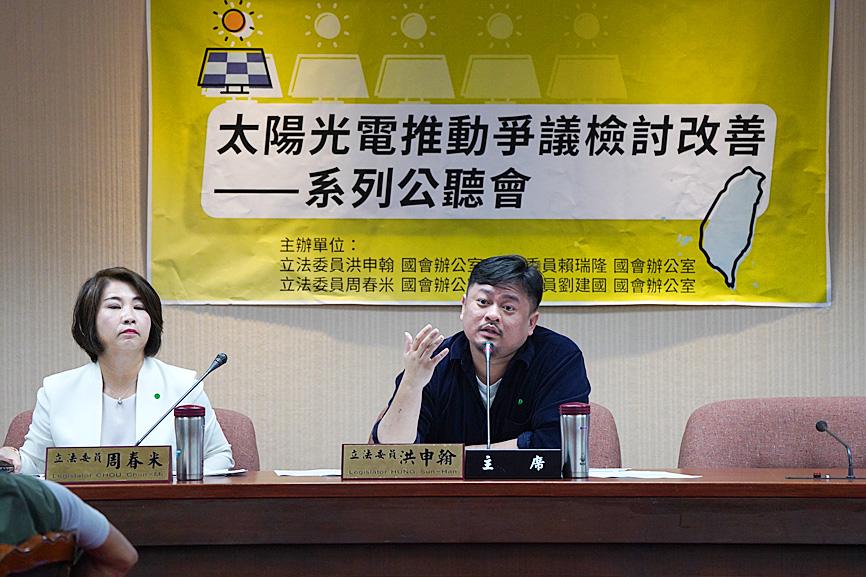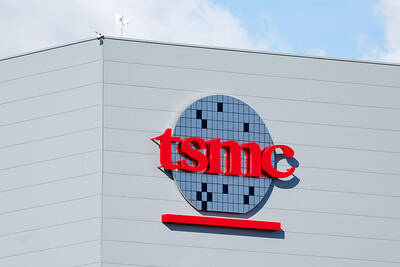New rules curbing solar farms built on agricultural land sparked fierce debate at a packed public hearing at the Legislative Yuan yesterday, with industry representatives saying that the new restrictions would endanger President Tsai Ing-wen’s (蔡英文) green energy goals, while agricultural officials emphasized the importance of protecting farmers and the environment.
The Tsai administration has set a target to generate 20 percent of the nation’s power from renewable sources by 2025, by which time it also aims to install 20 gigawatts (GW) of solar power, including 6GW from rooftop solar systems and 14GW from ground-mounted solar farms.
Although rooftop solar systems are not controversial, a proposal by contract chipmaker Taiwan Semiconductor Manufacturing Co (TSMC, 台積電) to clear 230 hectares of reforested land in Pingtung County to build Taiwan’s largest photovoltaic solar farm has raised concerns from local residents and environmental activists.

Photo: CNA
The Council of Agriculture amended the regulations governing the land use approval process on Tuesday last week to ban solar farms built on designated agricultural or aquaculture areas and tighten rules for solar farms built on all farmland.
Under the new measures, solar farms that cover an area of more than 2 hectares have to be approved by the council, instead of local governments. Currently, local agricultural authorities can approve solar farms covering an area of less than 30 hectares.
“While we are all working toward it, 2025 is not set in stone. Maybe it will be 2026 or 2027,” Council of Agriculture Minister Chen Chi-chung (陳吉仲) said at the hearing. “We will not sacrifice our farmers or the environment for solar, and contrary to media reports, we will not be cutting down forests in Pingtung.”
Chen called for more rooftop installations versus ground-mounted solar farms, and encouraged the nation to move toward a more diversified approach to green energy.
“I’m shocked to hear the minister’s blatant disregard for the government’s green energy goals,” Taiwan Photovoltaic Industry Association president Sam Hong (洪傳獻) said at the hearing.
“President Tsai’s policy is in danger ... 20 percent by 2025 is possible, but only if we stop flip-flopping on the rules,” said Hong, who is also the chairman of solar module maker United Renewable Energy Co (聯合再生).
Massive investments from the industry are on the line, and much of the forest slated to be cleared in Pingtung is of poor quality, said Hong, adding that there is plenty of disused agricultural land in Taiwan that could be used for solar farms.
“There is up to 200,000 hectares of farmland in Taiwan that is not being cultivated,” Hong said. “Just give us 20,000 hectares and that is all we need.”
There is a solid demand for renewable energy from Taiwan’s technology sector. Following the examples of Apple Inc and Alphabet Inc’s Google, TSMC aims to be 100 percent powered by renewable energy.
Last week, TSMC inked a 20-year deal with Orsted A/S to purchase all of the output from the energy company’s Greater Changhua 2b and 4 offshore wind farm, which is to produce 920 megawatts of power, making it the largest-ever contract of its kind in the renewable energy sector.
However, even wind power is not without controversy. More than 200 angry residents in Yunlin County gathered on Friday to protest offshore wind farms they said are too close to the shore and affect local fishermen and residents’ quality of life.

On Tuesday, US President Donald Trump weighed in on a pressing national issue: The rebranding of a restaurant chain. Last week, Cracker Barrel, a Tennessee company whose nationwide locations lean heavily on a cozy, old-timey aesthetic — “rocking chairs on the porch, a warm fire in the hearth, peg games on the table” — announced it was updating its logo. Uncle Herschel, the man who once appeared next to the letters with a barrel, was gone. It sparked ire on the right, with Donald Trump Jr leading a charge against the rebranding: “WTF is wrong with Cracker Barrel?!” Later, Trump Sr weighed

Taiwan Semiconductor Manufacturing Co (TSMC, 台積電) secured a record 70.2 percent share of the global foundry business in the second quarter, up from 67.6 percent the previous quarter, and continued widening its lead over second-placed Samsung Electronics Co, TrendForce Corp (集邦科技) said on Monday. TSMC posted US$30.24 billion in sales in the April-to-June period, up 18.5 percent from the previous quarter, driven by major smartphone customers entering their ramp-up cycle and robust demand for artificial intelligence chips, laptops and PCs, which boosted wafer shipments and average selling prices, TrendForce said in a report. Samsung’s sales also grew in the second quarter, up

HEADWINDS: Upfront investment is unavoidable in the merger, but cost savings would materialize over time, TS Financial Holding Co president Welch Lin said TS Financial Holding Co (台新新光金控) said it would take about two years before the benefits of its merger with Shin Kong Financial Holding Co (新光金控) become evident, as the group prioritizes the consolidation of its major subsidiaries. “The group’s priority is to complete the consolidation of different subsidiaries,” Welch Lin (林維俊), president of the nation’s fourth-largest financial conglomerate by assets, told reporters during its first earnings briefing since the merger took effect on July 24. The asset management units are scheduled to merge in November, followed by life insurance in January next year and securities operations in April, Lin said. Banking integration,

LOOPHOLES: The move is to end a break that was aiding foreign producers without any similar benefit for US manufacturers, the US Department of Commerce said US President Donald Trump’s administration would make it harder for Samsung Electronics Co and SK Hynix Inc to ship critical equipment to their chipmaking operations in China, dealing a potential blow to the companies’ production in the world’s largest semiconductor market. The US Department of Commerce in a notice published on Friday said that it was revoking waivers for Samsung and SK Hynix to use US technologies in their Chinese operations. The companies had been operating in China under regulations that allow them to import chipmaking equipment without applying for a new license each time. The move would revise what is known